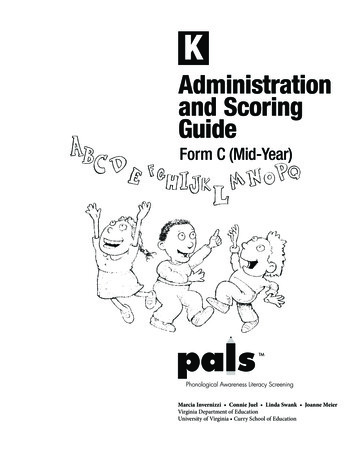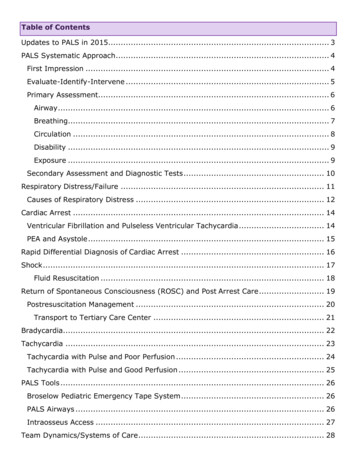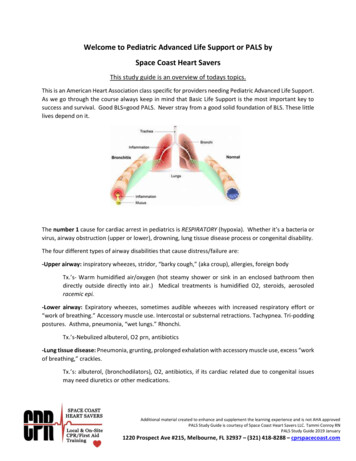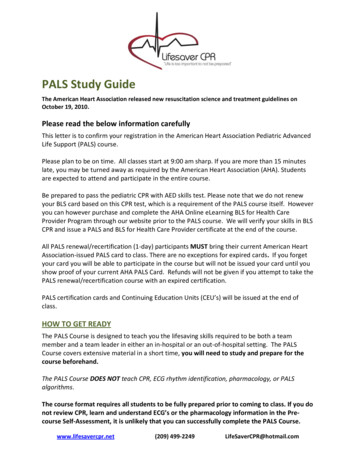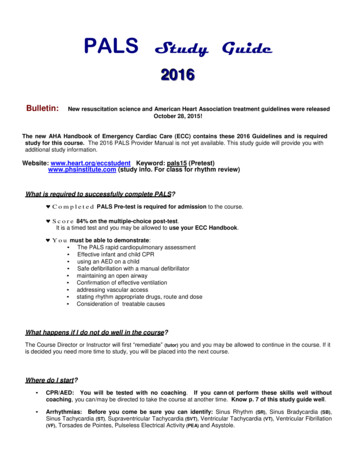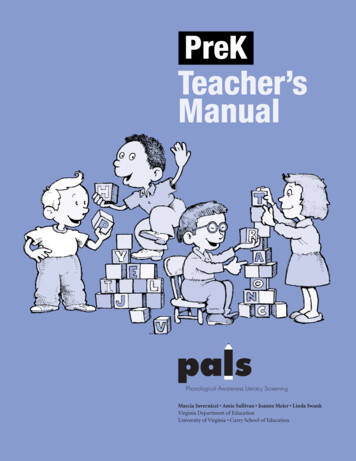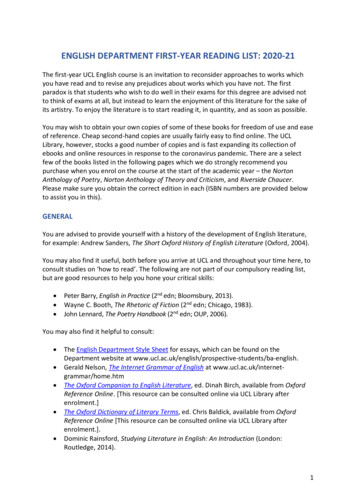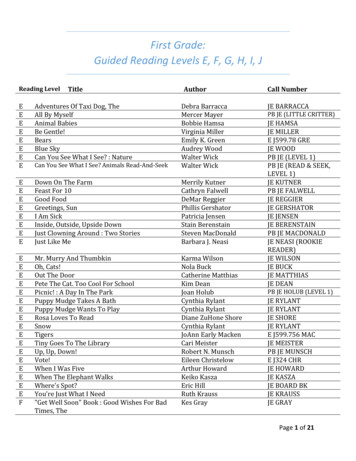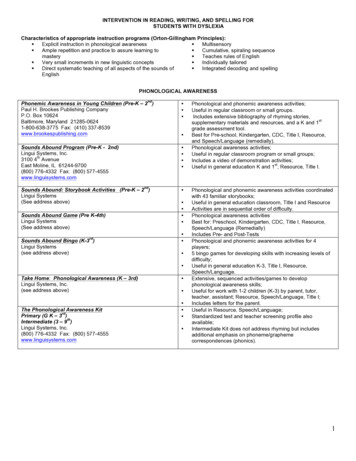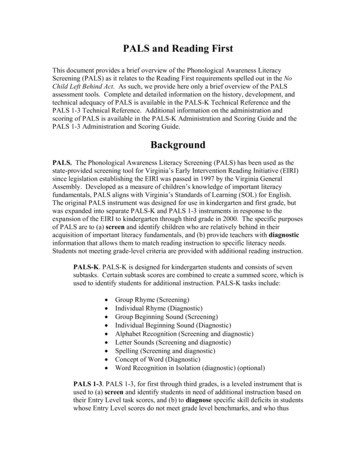
Transcription
PALS and Reading FirstThis document provides a brief overview of the Phonological Awareness LiteracyScreening (PALS) as it relates to the Reading First requirements spelled out in the NoChild Left Behind Act. As such, we provide here only a brief overview of the PALSassessment tools. Complete and detailed information on the history, development, andtechnical adequacy of PALS is available in the PALS-K Technical Reference and thePALS 1-3 Technical Reference. Additional information on the administration andscoring of PALS is available in the PALS-K Administration and Scoring Guide and thePALS 1-3 Administration and Scoring Guide.BackgroundPALS. The Phonological Awareness Literacy Screening (PALS) has been used as thestate-provided screening tool for Virginia’s Early Intervention Reading Initiative (EIRI)since legislation establishing the EIRI was passed in 1997 by the Virginia GeneralAssembly. Developed as a measure of children’s knowledge of important literacyfundamentals, PALS aligns with Virginia’s Standards of Learning (SOL) for English.The original PALS instrument was designed for use in kindergarten and first grade, butwas expanded into separate PALS-K and PALS 1-3 instruments in response to theexpansion of the EIRI to kindergarten through third grade in 2000. The specific purposesof PALS are to (a) screen and identify children who are relatively behind in theiracquisition of important literacy fundamentals, and (b) provide teachers with diagnosticinformation that allows them to match reading instruction to specific literacy needs.Students not meeting grade-level criteria are provided with additional reading instruction.PALS-K. PALS-K is designed for kindergarten students and consists of sevensubtasks. Certain subtask scores are combined to create a summed score, which isused to identify students for additional instruction. PALS-K tasks include: Group Rhyme (Screening)Individual Rhyme (Diagnostic)Group Beginning Sound (Screening)Individual Beginning Sound (Diagnostic)Alphabet Recognition (Screening and diagnostic)Letter Sounds (Screening and diagnostic)Spelling (Screening and diagnostic)Concept of Word (Diagnostic)Word Recognition in Isolation (diagnostic) (optional)PALS 1-3. PALS 1-3, for first through third grades, is a leveled instrument that isused to (a) screen and identify students in need of additional instruction based ontheir Entry Level task scores, and (b) to diagnose specific skill deficits in studentswhose Entry Level scores do not meet grade level benchmarks, and who thus
2proceed to subsequent diagnostic levels of PALS (Level B tasks, and Level Ctasks)Entry Level (Screening) Spelling Word Recognition in Isolation Letter Sounds (in Fall of First grade only)Level A: Oral Reading in Context (Screening & Diagnostic) Accuracy Fluency ComprehensionLevel B: Alphabetics (Diagnostic) Alphabet Recognition Letter Sounds Concept of WordLevel C: Phonemic Awareness (Diagnostic) Blending Sound-to-letter (or segmenting)Reading First. A part of the No Child Left Behind Act of 2001, Reading First requiresthat participating states assess students in reading, monitor students’ progress, anddetermine the extent to which goals for literacy are met. Specifically, states are requiredto use assessment tools that accomplish each of four purposes of assessment: (a)screening, (b) diagnosis, (c) progress monitoring, and (d) outcomes assessment.Moreover, states are required to assess students in five core reading areas: (a) phonemicawareness, (b) phonics, (c) fluency, (d) vocabulary, and (e) comprehension.We address each of these areas or domains. First we describe the use of PALS for eachof the four assessment purposes; then we provide a brief overview of the PALSinstruments with particular attention to the ways in which the five essential componentsof reading are addressed.How does PALS achieve each of the four purposes ofassessment spelled out in Reading First?In this section we describe the use of PALS for different assessment purposes spelled outin Reading First legislation: screening, diagnosis, progress monitoring, and outcomesassessment. For each assessment purpose, we also delineate exactly what PALS providesfor teachers.Screening. PALS was developed with the specific charge of helping to identify childrenwho are in need of additional instruction in key literacy fundamentals. PALS remains the
3state-provided screening tool for Virginia’s Early Intervention Reading Initiative, and isused by 98% of school districts in Virginia on a voluntary basis to identify students whoare to receive additional reading instruction through the EIRI. Five years of statewidedata collection with children in grades K-3 in Virginia have allowed the refinement of thesummed score benchmarks used to identify students in need of additional instruction.Because the Virginia Standards of Learning (SOL) has become a standard outcomemeasure and indicator of proficiency for students in Virginia public schools, weexamined the relationship between PALS scores and SOL performance. We conducted adiscriminant analysis on a sample of 799 students across three districts for whom we hadSOL scores and PALS scores from fall of third grade, fall of second grade, and fall ofkindergarten. That is, in this analysis we used a linear combination of PALS scores frommultiple screenings to predict whether students would pass the 3rd grade English SOL.The combination of PALS scores produced a discriminant function that accuratelyclassified 82% of students as pass or fail on the SOL.As a screening tool, what does PALS provide? PALS allows schools to identifystudents who are at risk of reading failure because they are behind grade-levelexpectations in important literacy fundamentals. Benchmarks have been established forPALS-K and for PALS 1-3 and students failing to meet these benchmarks are clearlybelow grade level expectation and thus at risk for reading failure. In Virginia, studentsfailing to meet the benchmarks for PALS-K and PALS 1-3 are provided with additionalinstruction under the EIRI.Diagnosis. PALS was created with the express purposes of both screening to identifystudents in need of additional instruction, and also providing explicit diagnosticinformation that teachers could use to guide their instruction. For example, on PALS 1-3,students who do not meet the entry-level criterion are further assessed in Levels B and C:Alphabetics and Phonemic Awareness. In addition, an instructional reading level isestablished for each student, as well as an instructional level for spelling/phonicsknowledge. For PALS–K, students who do not meet the criteria for the two groupadministered phonological awareness tasks are further assessed for their awareness ofsounds in an individual, one-on-one format. All tasks on PALS-K provide diagnosticinformation with regard to the knowledge students have about important literacyfundamentals (i.e., specific letters and letter sounds).As a diagnostic tool, what does PALS provide? PALS provides teachers with aprofile of the areas in which particular students are in need of additional instruction.Thus, PALS does not merely designate a child as ‘at risk,’ but also provides teachers withexplicit information about where to begin instruction and in what areas individualchildren need further help. For example, in addition to identifying students who are atrisk, PALS also: Groups students by instructional reading level after word list and oral readingpassage scores are entered,
4 Groups students by spelling/phonics knowledge when phonics/spelling featurescores are entered, andLinks to instructional activities within the PALS website.Progress Monitoring. The PALS instruments are designed to identify students in need ofadditional instruction, and for those identified, it is expected that they will be rescreenedduring the next screening window. On PALS 1-3, progress is monitored by growth inreading levels across the year and growth in phonics/spelling knowledge. On PALS-K,progress in monitored by increases in the phonological awareness scores and by growthin the number of letters recognized, the number of letter sounds pronounced, the numberof phonemes represented in the spelling task, and increases in the concept of word score.As a progress monitoring tool, what does PALS provide? PALS provides atleast two clear indicators of progress over time. PALS allows teachers to monitorchanges in students’ reading levels (based on their scores on Word Recognition inIsolation and Oral Reading in Context.tasks) over time, and also provides evidence ofgrowth in the spelling and phonics features children demonstrate over time.Outcomes assessment. Given its primary function as a screening and diagnostic tool, theuse of PALS as an assessment of outcomes is probably not justified. PALS is designed toidentify students in need of additional help in acquiring important literacy fundamentals,and as such has been examined primarily as a predictor of outcomes, rather than ameasure of outcomes. Indeed, Virginia’s statewide assessment, the Standards ofLearning, has become the primary means by which students’ success is documented.Assessment PurposeEssential componentsof reading laryXXX--ComprehensionXXX--Phonemic Awareness
5How does PALS focus on the essential components ofreading?Since its inception, PALS has focused on not only identifying children in need ofadditional instruction beyond that provided to typically developing readers, but also onproviding teachers with specific information to guide their instruction. As such, PALStasks were designed specifically to cover the important components of early literacy –components that were also identified in Reading First legislation. We provide a briefdescription of how PALS addresses each component.Phonemic Awareness. Phonemic awareness is assessed by three tasks in PALS-K andby two tasks in PALS 1-3. In PALS-K, the Rhyme Awareness task assesses children’sability to match orally presented rhymes that are cued by pictures. The student circles thepicture that rhymes with each item. Phonemic awareness is more specifically assessedwith two additional tasks: Beginning Sound Awareness and a Spelling measure scoredby the number of phonemes represented. The format of the Beginning Sound Awarenesstask is similar to the Rhyme Awareness task; that is, students circle the picture that hasthe same beginning sound as the targeted item. For the Spelling task, kindergartners areasked to spell five consonant-vowel-consonant (CVC) words, and their spelling attemptsare scored by the number of phonemes represented. Phonetically accurate lettersubstitutions are permitted so that a student representing the /s/ phoneme with a c, forexample, would be given credit for that phoneme.In PALS 1-3, phonemic awareness is assessed with two phoneme awareness tasks:Blending and Sound-to-Letter. In the Blending subtask, students are asked to blendindividual phonemes together to come up with a word (e.g., /c/ /a/ /t/ cat). Itemsmove from two-phoneme words to four-phoneme words. The Sound-to-Letter taskrequires phoneme segmentation in addition to knowledge of letter sounds. The teachersays a word (e.g. map); the student segments various phonemes within that word and tellsthe teacher the letter that represents each phoneme. Sound-to-Letter items assessstudents’ ability to segment the beginning, ending, and medial phoneme.Phonics. Children’s knowledge of phonics is assessed by two tasks on both PALS-K andPALS 1-3: Spelling and Letter Sounds. Kindergartners are asked to spell five CVCwords. Teachers score students' spelling attempts by the number of phonemesrepresented. Phonetically accurate substitutions are accepted. Students in grades 1through 3 are asked to spell lists of words representing phonics features that should havebeen acquired to be successful at each grade level. Teachers score spellings by specificphonics features represented. For example, students who correctly represent a consonantblend would get credit for its presence even if they misspelled other parts of the word.The second phonics task is Letter Sound knowledge. On PALS-K, all kindergartners areassessed for their knowledge of letter sounds. On PALS 1-3, all first graders are assessedfor their knowledge of letter sounds in the fall. Letter Sound knowledge is part of thediagnostic assessment for all first, second and third graders taking PALS 1-3.
6Fluency. Children’s oral reading fluency is assessed by one task on PALS-K and onetask scored for 3 aspects of reading fluency on PALS 1-3. PALS-K is used to assessesthe accuracy and fluency of students’ ability to demonstrate one-to-one correspondencebetween words recited from a memorized nursery rhyme and those same words printed ina four-line stanza in the Concept of Word task. PALS 1-3 is used to assess students’ oralreading fluency through the Oral Reading in Context task (ORC). The ORC task yieldsthree measures of oral reading fluency: (a) oral reading accuracy, (b) phrasing,intonation, and expression, and (c) reading rate.Vocabulary. Vocabulary is assessed in both PALS-K and PALS 1-3 using the WordRecognition in Isolation task. Word Recognition in Isolation assesses children’srecognition of core reading vocabulary in a series of graded word lists. Three word listsare provided for PALS-K, and these correspond to the core reading vocabularyencountered at the beginning, middle, and end of grade one. Three additional word listsare provided for PALS 1-3.Comprehension. Comprehension is assessed in PALS 1-3 following the Oral Reading inContext task. After reading a passage out loud, students answer a set of comprehensionquestions about that passage. The comprehension questions are in a multiple-choiceformat. Teachers read the questions and the answer options aloud to students who readon a primer or first-grade reading
PALS-K and for PALS 1-3 and students failing to meet these benchmarks are clearly below grade level expectation and thus at risk for reading failure. In Virginia, students failing to meet the benchmarks for PALS-K and PALS 1-3 are provided with additional instruction under the EIRI. Diagnosis. PALS was created with the express purposes of both screening to identify students in need of .
